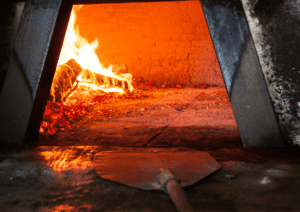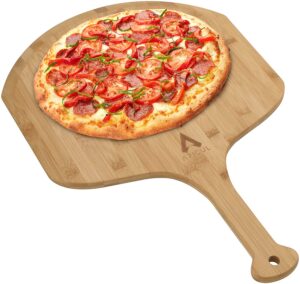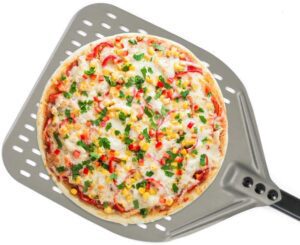Wood and metal pizza peel, which is better? You must be confused when you’re a chef or in the habit of making pizzas at home; it’s certain that you know the importance of a pizza peel. However, if you are indecisive about what kind of pizza peel you need, this guide can help.
If you’re well into the business, you’d have come across two types of pizza peels; wood and metal pizza peels. But the question is: what exactly is the difference between a wood and metal pizza peel?
Don’t be impatient; we’re going to dig deep into what they’re, how they differ, and what type of pizza peel you need. But first things first, let’s unfold what exactly pizza peels are and what they’re used for.
Key Takeaways
Wooden pizza peels offer rustic charm, grip, and a natural feel, preserving pizza flavor and appealing to purists. Metal peels are durable, easy to maintain, lightweight, and offer versatility, but can be slippery and impact taste. Choose based on your aesthetics, cooking style, and priorities.
Wood vs. Metal Pizza Peel: an Overview of Key Differences
| Feature | Wood | Metal |
| Material | Wood (typically bamboo or maple) | Metal (aluminum, stainless steel) |
| Durability | Less durable, prone to warping and cracking | More durable, resistant to rust and corrosion |
| Appearance | Natural, rustic, aesthetically pleasing | Sleek, modern, minimalist |
| Weight | Heavier | Lighter |
| Grip | Excellent, due to the texture of the wood | Good, but can be slippery, especially with coatings or perforations |
| Control | Good, due to the flexibility of the wood | Less flexible, potentially impacting precise control |
| Heat conductivity | Poor conductor, safer to handle | Good conductor, efficient for pizza transfer |
| Versatility | Primarily for pizza transfer | Can double as a pizza screen and cutting board |
| Ease of cleaning | More difficult, absorbs oils and requires gentle cleaning | Easier, dishwasher-safe (some) |
| Price | More expensive | Less expensive |
| Best for | Traditional pizza-making style, those who value aesthetics and grip | Busy cooks, those who value practicality and modernity |
What is a Pizza Peel, and What are its Different Types?
A pizza peel is a kitchen tool that resembles a large, flat shovel or paddle. It’s a must-have for pizza enthusiasts and professional pizzaiolos alike. This handy tool is used to slide pizzas in and out of a hot oven or a pizza stone. The peel’s long handle allows you to reach deep into the oven without risking burns, while the flat, thin surface ensures your pizza maintains its shape during the transfer process. Whether you’re baking homemade pizzas or managing a bustling pizzeria, a pizza peel is your trusty assistant, ensuring your pizzas slide effortlessly into the oven and onto your plate.
Before discussing the difference between wood and metal pizza peels, it’s time to learn about the types of pizza peels based on what they’re used for.
Launching Pizza Peels

The launching pizza peel refers to large and flat peels mainly used in restaurants and pizza shops. Launching pizza peels are used to put pizza or bread in the oven and to remove them.
They’re made of wood or metal. A launching pizza peel is not suitable for rotating pizza.
If you want to do so, you may have to pull the pizza out using a launching peel and turn it by hand. After rotating the pizza, you can replace it in the oven using the same launching peel.
Turning Pizza Peels
The turning pizza peel refers to peels that have smaller and circular paddles with slots in them. The purpose of having slots in them is to prevent the pizza from sticking. These peels always come with a metal paddle and a wood or rubber handle. Wood or rubber handles are used to minimize heat transfer.
Now that you’ve learned about launching and turning peels, we should discuss the two types of pizza peels based on the material used.
What are Wooden Pizza Peels?
Wooden pizza peels are type of launching peels used for preparing and transferring pizzas in and out of ovens. Crafted from smooth, durable wood like bamboo or maple, these peels have a broad, flat surface and a long handle. They serve a dual purpose: the thin edge easily slides under the pizza, while the long handle keeps your hands safe from the oven’s heat.
Why wooden? Wood doesn’t conduct heat as metal does, preventing the pizza from sticking. Plus, they’re excellent for creating that authentic pizzeria flair at home. With a wooden pizza peel, your homemade pizzas effortlessly slide into the oven, ensuring a perfect bake every time!
What are Metal Pizza Peels?
Metal pizza peels include both launching and turning peels. These sleek, flat paddles are crafted from durable metals like aluminum and stainless steel. They are designed to effortlessly slide under your pizza, ensuring a smooth transfer into and out of the oven.
Unlike their wooden counterparts, metal pizza peels are thin, lightweight, and excellent conductors of heat. You can find metal pizza peels in 4 types, which are listed below.
Aluminum Pizza Peels
Lightweight and easy to maneuver, aluminum peels are favored by many home cooks and professionals alike. They come in various sizes, offering flexibility in handling different pizza sizes.
Stainless Steel Pizza Peels
Known for their durability and resistance to rust, stainless steel peels are perfect for busy commercial kitchens. They are sturdy, ensuring your pizzas are moved swiftly and safely.
Perforated Metal Pizza Peels
These innovative peels feature small holes on the surface, preventing the dough from sticking. The perforations allow excess flour and cornmeal to fall through, ensuring a seamless pizza transfer without mess.
Foldable Metal Pizza Peels
Ideal for compact storage, these peels have a hinge mechanism, allowing the paddle to fold in half. This space-saving design is perfect for home kitchens with limited storage space.
Metal pizza peels are essential for achieving a perfectly baked pizza crust, making them a must-have tool for any pizza lover’s kitchen adventures!
Turning Peels
These peels have a smaller, circular paddle than solid peels. They are designed for turning pizzas in the oven, as the small size makes it easier to maneuver the pizza without burning yourself.
Pizza Peel Wood or Steel: What’re the Difference?
Wood and metal, both peels, have their merits and demerits. We’ve provided a brief comparison of both types in the following:
1. Durability
Regarding longevity, metal pizza peels are considered more durable than wood pizza peels. Wood pizza peels, on the other hand, have no elasticity and are prone to breakage.
2. Appearance
When it comes to design and looks, wood peels stand out from metal ones. It’s because they provide a more natural look, have aesthetic appeal, and are soothing to feel.
Metal pizza peels, however, offer a range of design options to select from. Most of them feature a customizable handle that can be adjusted to suit your needs, and it makes sliding the pizza a snap.
3. Weight
Metal pizza peels are thin and lightweight. Wood peels, on the contrary, are thick and heavier in weight. If you’re a minimalist, a metal pizza peel is a great match for you because of its low weight.
4. Grip
Wooden pizza peels have a natural advantage when it comes to grip. The texture of wood provides a secure hold, ensuring your pizza won’t slip during transfer. On the other hand, metal peels, especially when coated or perforated, can be slippery. However, some metal peels come with rubber or wooden handles to enhance grip, although they may not match the natural grip of wood.
5. Control
Wooden pizza peels offer better control due to their sturdy yet slightly flexible nature. It’s easier to slide the peel under the pizza and maneuver it in tight spaces. Metal peels, while thin and lightweight, might lack a bit in flexibility, affecting precise control, especially for beginners.
6. Heat Conductivity
Metal pizza peels, particularly those made from aluminum, excel in heat conductivity. They quickly absorb oven heat, making them efficient for swift pizza transfers. Wood, being a poor conductor of heat, doesn’t absorb as much heat. This property prevents the peel from becoming too hot to handle, offering a safety advantage, especially for novice pizza makers.
7. Versatility
Wooden peels are primarily designed for pizza transfer. They excel in this specific task due to their grip and ease of use. Metal peels, especially perforated ones, are versatile. They can double as pizza screens, allowing pizzas to bake directly on the peel, and some even serve as cutting surfaces due to their durability. This versatility gives metal peels an edge in multifunctionality.
8. Ease of Cleaning
Cleaning wooden peels can be tricky. They absorb oils and can develop stains and odors over time. Additionally, they require gentle cleaning to prevent damage. Metal peels, on the other hand, are easy to clean. They don’t absorb oils, and many are dishwasher-safe, making cleanup a breeze. Metal peels are low-maintenance and ideal for those seeking hassle-free maintenance.
9. Price
As for the price, metal peels are cheaper than wooden pizza peels.
If you cannot afford two pizza peels at once or don’t want clutter, there’s also a third option: a perforated metal peel with a wooden handle.
Concluding the Differences Between Wooden and Metal Pizza Peel
In the epic battle of wooden vs. metal pizza peels, your choice ultimately depends on your personal preferences and pizza-making style.
Wooden Pizza Peels offer a touch of rustic charm, excellent grip, and a natural feel. They are perfect for those who appreciate traditional aesthetics, maintain the authentic taste of the pizza, and prioritize a non-slip surface. While they require a bit of care, their timeless appeal and ability to preserve the pizza’s original flavors make them a favorite among purists.
Metal Pizza Peels, on the other hand, boast durability, easy maintenance, and a wide range of design options. They are lightweight, making them ideal for quick maneuvers in the oven. Metal peels are excellent for busy cooks who value practicality and modernity, allowing for easy sliding, turning, and maneuvering of pizzas. However, they can be slippery and might alter the taste of your pizza due to the material.
Consider your cooking needs, preferred pizza styles, and aesthetics. Whether you go for the classic elegance of wood or the sleek efficiency of metal, both peels have their unique advantages. Whichever you choose, may your pizza-making adventures be filled with delicious creations and joyful moments in the kitchen!
FAQs
What is a perforated metal pizza peel?
Perforated metal pizza peel contains a lot of holes in their paddles. The presence of holes makes them less sticky, just like wood pizza peels. In addition, It’s easy to clean and maintain.
Wooden pizza peels have a rough surface, and there’s no chance for a vacuum to build up between the surface and the pizza. Perforated metal pizza peels also perform the same function, letting air pass through the holes to prevent a vacuum. Consequently, perforated metal peels are almost non-stick.
What’s more, due to their decreased surface area, perforated metal peels offer little friction between the paddle and raw dough. Simultaneously, they retain less pizza flour and allow it to run off through holes.
What is the best wooden pizza peel?

APICUL Bamboo Pizza Peel is one of the finest wood pizza peels ever encountered. It’s made of bamboo wood and has garnered a 4.9 rating on Amazon. The best thing about this wooden pizza peel is its excellent resistance against splitting, cracking, and warping.
This wooden pizza peel has a natural, food-grade oil finish to prevent moisture absorption, making it stand out from thousands of others.
Another great thing about this peel is that it includes a large paddle and a long handle. In addition, it’s lightweight but sturdy.
Its board has tapered edges to facilitate its movement under the pizza.
Pros
- The wooden pizza peel is made of bamboo wood.
- It’s resistant to scraping, splitting, and warping.
- It contains a food-grade oil finish.
- The wooden pizza peel resists moisture absorption.
- It contains tapered edges to facilitate rotating and removing the pizza.
Cons
- The pizza peel has a sophisticated design.
3. What is the best perforated pizza peel?

HOMEFAVOR Perforated Pizza Peel is the best-perforated pizza peel. It comes with an anodized aluminium paddle to offer better wear and corrosion resistance. It’s because the thin film of anodized aluminum prevents the oxidation of the metal. It has sloping edges, making turning and removing pizza a breeze.
As far as the handle is concerned, it’s long enough to put the pizza in a large oven. Moreover, it features insulating plastic at the end of the handle to protect your hands from the indirect effects of heating.
Pros
- It contains an anodized aluminum paddle.
- Holes are numerous and small.
- It features a long handle with a plastic covering at the end.
Cons
- It has a conventional design.
How thick should a pizza peel be?
Metal pizza peels are generally approximately 1 to 3 millimetres- thick. A wood pizza peel is generally around 1/2 to 3/4 inch thick.
mama-cucina.com is a participant in the Amazon Associate program and will earn from qualifying purchases.

